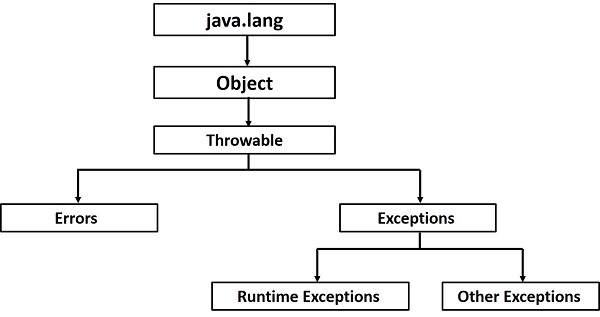An Exception is an abnormal condition that arises in the code sequence at run time. Java provides a mechanism to handle the Exception that occurs that run time so that you can have your code run smoothly instead of situations that might cause your code to break at run- time.
A java exception is an object that describes an exceptional condition that has occurred in the piece of code. Java exception handling is managed via five keywords try, catch, throw, throws and finally. We will learn about the usage of each of these terms subsequently.
As a general rule, the part of your code that might generate an Exception at run-time should be inside a try block and the catch condition should be inside a catch block. Following is the structure of exception handling block
//Block of code to monitor of Errors
}catch(ExceptionType1 exceptionObject){
//Exception Handler for ExceptionType1
}catch(ExceptionType2 exceptionObject){
//Exception Handler for ExceptionType2
}
Exception Types

All Exception types in Java are of type Throwable. Thus Throwable is at the top of Exception hierarchy. Immediately below Throwable are two subclasses that partition exception into Exception and Errors.
Errors are catastrophic failures which are usually not handled by our program. On the other hand Exceptions class is used for exceptional conditions that user program should catch. There is an important subclass of Exception i.e. Runtime Exceptions. Exceptions of this type are automatically defined for the programs that you write and include things such as division by zero and invalid array indexing.
Why Exceptions?
Before we start looking at how to catch the Exceptions, Let's look at why there is a need of Exception Handling. Let's write a program which does not handle the exceptions.
public class NoHandling {
public static void main(String args[]) {
int d = 0;
int a = 232 / d;
}
}
On running this program will generate the following stack trace.
at info.FiveBalloons.Examples.NoHandling.main(NoHandling.java:7)
The stacktrace will show the sequence of method invocation that led up to the error. This is the default exception handling provided by the Java run-time system. But you will want to handle the exceptions yourself. Doing so provides two benefits.
1. It allows you to fix the error.
2. It prevents the program from automatically terminating.
Let's fix the above piece of code using Java Exception Handling.
public class NoHandling {
public static void main(String args[]) {
int d, a;
try {
d = 0;
a = 232 / d;
} catch (ArithmeticException e) { // Catch divide-by-zero Errors
a = 0;
System.out.println("Division by Zero, setting value of a as 0");
}
}
}
As you can see in the catch block we have adjusted the value of a, as well as handled the exception so that the code does not terminate at the exception.